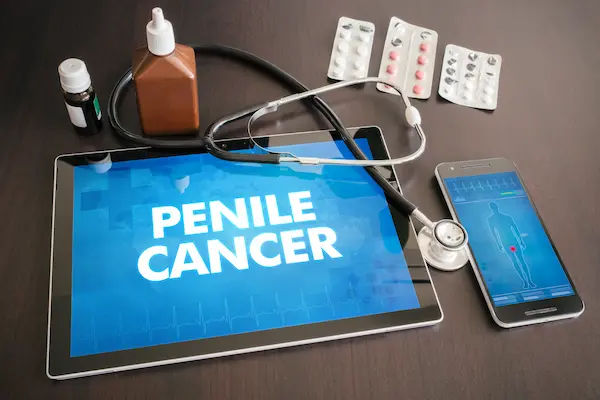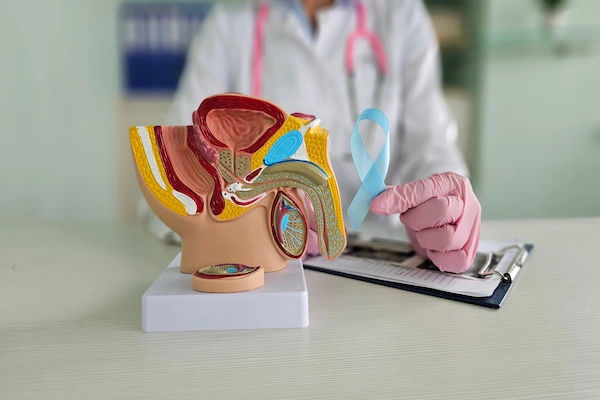Penile Cancer: Early Signs, Causes, and Next Steps
Learn about early signs of penile cancer, causes, risk factors, diagnosis, treatment options, and prevention steps including HPV vaccination, hygiene, and lifestyle measures.


Introduction
Penile cancer is uncommon, but its early signs are often easy to miss or confuse with minor infections or rashes. The good news is that most early changes are treatable, especially when identified quickly. This guide explains what leads to the signs of penile cancer—why a sore, red patch, growth, discharge, or swollen groin nodes might appear—and when they should prompt a medical visit. We break down the real-world symptoms, the risk factors that raise your chances, and how doctors diagnose and treat penile cancer in ways that preserve function whenever possible. You will also learn how HPV and foreskin-related issues contribute to risk, what look-alike conditions can mimic cancer, and practical prevention steps you can start today. Whether you are worried about a persistent spot or want to protect your long-term health, this clear, compassionate overview is designed for you and your partner. If symptoms persist beyond two weeks, consult a doctor online with Apollo 24|7 for further evaluation. Early care matters and can make all the difference.
What Counts as an Early Sign of Penile Cancer?
Here's what to look for when identifying possible early symptoms:
The Most Common Symptoms You Might Notice
Penile cancer usually starts on the glans (head), foreskin, or shaft skin. Early signs that deserve attention include:
- A sore, ulcer, or growth that does not heal within 2–3 weeks
- A red, velvety patch or area of skin thickening
- A wart-like bump or crusted lesion
- Persistent itching, burning, or tenderness in one spot
- Discharge under the foreskin, sometimes with a foul smell
- Bleeding from a lesion or from under the foreskin
- Changes in colour or a non-healing crack/fissure on the glans
- Painless swelling or lumps in the groin (inguinal lymph nodes), which can signal spread
Early penile cancer is often superficial, so the only clue may be a subtle skin change. Localised disease diagnosed early is associated with much better outcomes than advanced disease. If you notice a persistent, localised abnormality—especially a sore or growth—do not “wait and see” beyond two weeks.
Consult Top Specialists
Symptoms That Mimic Benign Problems (Balanitis, STIs, Eczema)
Many common issues can resemble penile cancer:
- Balanitis often causes redness, soreness, and discharge. Fungal (Candida) infections can cause bright red patches and itching
- Sexually transmitted infections (e.g., syphilis, herpes) can cause ulcers or sores
- Dermatitis/eczema and psoriasis can create red, scaly plaques
- Lichen sclerosus can cause white, thin, shiny patches and scarring, especially on the foreskin or glans
Clues favouring cancer include a solitary lesion that slowly enlarges, bleeds, or ulcerates; a velvety, red patch that does not respond to standard creams; or any firm, tethered growth. When in doubt, a clinician’s examination and biopsy will make the distinction.
When to Watch, When to Act: Timelines and Urgency
- Seek care promptly if a lesion lasts beyond two weeks, is enlarging, bleeds, or is associated with swollen groin nodes
- Mild diffuse irritation that improves within a week with hygiene measures or antifungal cream may be monitored—but persistent or recurrent symptoms need evaluation
- If your foreskin is tight (phimosis) and you cannot fully retract it for cleaning, you are at higher risk and should not delay medical review. If symptoms persist beyond two weeks, consult a doctor online with Apollo 24|7 or book a physical visit for examination
What Leads to These Signs? Key Causes and Risk Factors
Here's why these changes occur:
HPV Infection: How It Drives Penile Cancer
Human papillomavirus (HPV), especially high-risk types like HPV 16, can cause precancerous changes (penile intraepithelial neoplasia, PeIN) that appear as red or velvety patches and, over time, progress to invasive cancer if untreated. HPV-related lesions often present with persistent, non-healing surface changes. HPV vaccination greatly reduces infection risk; consistent condom use lowers but does not eliminate transmission risk.
Foreskin-Related Risks: Phimosis, Poor Hygiene, Chronic Inflammation
Phimosis (a foreskin too tight to retract) is strongly associated with penile cancer risk because it traps moisture and secretions, increasing chronic inflammation and infection. Poor hygiene under a non-retractile foreskin allows smegma buildup and persistent irritation, which can lead to redness, malodor, and discharge—some of the same signs seen in early penile cancer. Regular gentle retraction and cleaning (if retractable) can reduce inflammation, while circumcision can treat phimosis and, when performed before sexual debut, appears protective.
Smoking, Lichen Sclerosus, and Other Inflammatory Conditions
Smoking damages local immune defences and is associated with increased penile cancer risk. Lichen sclerosus, a chronic inflammatory skin condition, can cause white plaques, scarring, and urethral narrowing; it is linked to PeIN and invasive cancer in a minority of cases. Uncontrolled recurrent infections or chronic dermatologic irritation can also promote precancerous change. Treat persistent inflammation early and quit smoking to decrease risk.
Age, Immune Suppression (HIV/Medications), and Other Factors
Risk rises with age, but younger men can be affected, especially with HPV-related disease. Immune suppression (HIV infection or long-term immunosuppressive therapy) increases risk and can change how lesions look or heal. Rarely, prior UV/PUVA therapy to the genital area for psoriasis without shielding has been linked to increased risk.
Circumcision and Risk: What the Evidence Says
Circumcision in infancy or childhood appears protective, likely by reducing chronic inflammation and HPV persistence. Adult circumcision treats phimosis but does not erase prior exposures. Regardless of circumcision status, practising good hygiene, avoiding tobacco, and getting HPV vaccination remain core prevention strategies.
From Precancer to Cancer: What’s Happening in the Tissue
Here's a look at tissue changes in penile cancer progression:
Precancerous Lesions (PeIN, CIS, Erythroplasia of Queyrat, Bowen Disease)
Penile intraepithelial neoplasia (PeIN) and carcinoma in situ (CIS) are surface-only precancers. On the glans, CIS is often called erythroplasia of Queyrat; on shaft skin, it can be Bowen disease. These lesions can cause itching, burning, redness, and occasional bleeding. Without treatment, a subset progresses to invasive cancer over time. Topical therapy or minor procedures can often clear PeIN/CIS.
The Most Common Cancer Type: Squamous Cell Carcinoma
Around 95% of penile cancers are squamous cell carcinoma (SCC), a cancer of the skin-like squamous cells. SCC can form ulcers, outward-growing masses, or thickened plaques. Some subtypes are HPV-related and may present as warty lesions; others arise from chronic inflammation and may be more ulcerative.
Why Some Lesions Bleed or Smell: Biology Behind the Signs
As precancer or cancer grows, it disrupts the skin’s barrier. Fragile, abnormal blood vessels can bleed, and ulcerated surfaces can harbour bacteria, causing discharge and odour. Thickening or firmness can reflect deeper invasion. Swollen groin nodes may occur as the immune system reacts—or if cancer spreads to lymph nodes.
How Doctors Diagnose Penile Cancer?
Here's what to expect during assessment:
What to Expect at the Exam and History
A clinician will ask when the symptom began, how it changed, any pain or bleeding, sexual history, prior skin conditions, and hygiene habits. They will examine the penis (including retracting the foreskin if possible) and feel the groin for lymph nodes. Photos documenting changes over time can be helpful. If your condition does not improve after trying basic hygiene or antifungal treatment, book a physical visit to a doctor with Apollo 24|7.
Biopsy Types and What Your Report Means
A biopsy confirms diagnosis. Depending on location and size, your doctor may do:
- Punch biopsy for small superficial lesions
- Incisional biopsy for larger lesions
- Excisional biopsy if the entire small lesion can be removed
Pathology identifies whether it is benign, precancer (PeIN/CIS), or invasive cancer, and can test for HPV-related features. This report guides treatment.
Imaging and Staging: MRI/CT/PET and Lymph Node Assessment
If invasive cancer is confirmed, imaging evaluates depth and spread:
- MRI helps assess local invasion
- Ultrasound can evaluate lesion depth and regional nodes
- CT or PET/CT checks for nodal or distant spread in higher-stage disease
Lymph node management is critical because spread to the groin markedly affects prognosis. In select cases, a sentinel lymph node biopsy helps determine if microscopic spread has occurred.
Ruling Out Look-Alikes (STIs, Psoriasis, Fungal Infection)
Doctors may also test for STIs (e.g., syphilis, HSV) or fungal infections if the presentation is ambiguous. Apollo 24|7 offers convenient home collection for routine lab tests; a doctor can advise whether STI panels or other tests are relevant to your case.
Treatment Options by Stage and Goal
Here's how treatment varies by stage:
Organ-Preserving Approaches (Topicals, Laser, Mohs/Glands Resurfacing)
For PeIN/CIS or very superficial cancers:
- Topical medications such as 5-fluorouracil (5-FU) or imiquimod can clear many in-situ lesions
- Laser ablation or Mohs micrographic surgery allows precise removal while sparing healthy tissue
- Glans resurfacing or glansectomy can remove diseased tissue while preserving shaft length
These approaches aim to maintain appearance and sexual/urinary function, with careful follow-up because recurrences can occur.
Surgery: Circumcision, Partial/Total Penectomy
- Circumcision treats foreskin-limited disease and improves hygiene access
- Partial penectomy removes the tumour with a margin, preserving as much length as safely possible
- Total penectomy with perineal urethrostomy is reserved for extensive disease
- Modern reconstructive options and penile prosthetics may help restore function and confidence in select cases.
Radiation Therapy: External Beam and Brachytherapy
Radiation can be used for organ preservation or when surgery is not feasible:
- External beam radiation therapy (EBRT) treats the penile lesion and/or groin nodes
- Brachytherapy (internal radiation) can control small, localised tumours while preserving tissue
- Radiation requires expertise to minimise skin toxicity and maintain function.
Lymph Nodes: Sentinel Node Biopsy and Dissection
Managing groin nodes is crucial. When risk of microscopic spread is significant, sentinel node biopsy or inguinal lymph node dissection (ILND) is considered. Treating involved nodes improves survival but carries risks like lymphedema; techniques to reduce complications are continually improving.
Systemic Therapy: Chemotherapy and Immunotherapy
For advanced or node-positive disease, chemotherapy regimens (often involving cisplatin, 5-FU, and/or taxanes) are used. Immunotherapy (checkpoint inhibitors) may be an option in select cases, especially if tumours show certain biomarkers. Clinical trials are important and may offer access to newer treatments.
Side Effects and Recovery: What Helps in Real Life
Expect temporary pain, swelling, or urinary changes after local procedures. Pelvic floor therapy, scar care, and sexual counselling can improve outcomes. Fatigue, skin changes, and nausea may occur with radiation or chemotherapy—early symptom reporting helps teams manage these effects.
Living Well During and After Treatment
Here's how to manage daily life and wellbeing:
Sexual Health, Intimacy, and Fertility
Open communication with your partner can reduce anxiety and improve intimacy. Depending on treatment, strategies may include lubricants, PDE5 inhibitors, vacuum devices, or penile prostheses. If you may need systemic therapy, ask about sperm banking beforehand. Reframe intimacy beyond penetration to maintain connection during recovery.
Urinary Function, Devices, and Daily Life
After partial penectomy or reconstructive surgery, sitting to urinate may be more comfortable initially. Occupational therapy can help with clothing modifications and hygiene. Report any narrowing of the urinary stream (possible stricture) early.
Mental Health, Body Image, and Social Support
It is normal to grieve changes. Counselling, peer support groups, and sex therapy can be invaluable. Consider involving a partner or trusted friend in appointments. Anxiety tends to decrease once a clear plan is in place.
Prevention and Risk Reduction You Can Start Today
Here's how to reduce your risk:
HPV Vaccination and Safer Sex
HPV vaccination (ideally before sexual debut, but beneficial up to age recommendations in your country) reduces the risk of HPV-related penile cancer. Condoms lower transmission risk but are not fully protective—combine with vaccination for best protection.
Hygiene and Foreskin Care: Practical Steps
- If your foreskin retracts: gently retract, rinse with lukewarm water (mild soap if needed), dry, and replace the foreskin daily
- If you cannot retract: see a clinician—topical steroids or circumcision may be recommended
- Treat recurrent balanitis or dermatitis early to reduce chronic inflammation
Quit Smoking and Treat Skin Conditions Early
Quitting smoking reduces penile cancer risk and improves healing. Manage lichen sclerosus, psoriasis, and eczema with medical guidance to minimise long-term irritation.
Protecting Skin from UV and Irritants
If you receive light-based skin treatments for conditions like psoriasis, ensure proper genital shielding. Avoid harsh products on sensitive skin and address any new irritation promptly.
Talking with Your Doctor: Smart Questions to Ask
Here's what to discuss with your clinician:
Symptoms and Diagnosis
- What is the most likely diagnosis? What else could it be?
- Do I need a biopsy now, or is a short trial of treatment reasonable?
- If this is precancer, what is my risk of progression?
Treatment, Recovery, and Follow-Up
- What are my organ-sparing options? What are the recurrence rates?
- How will this affect sexual function and urination? What rehab is available?
- How often will I need follow-up exams and imaging?
Sexual Function, Fertility, and Support
- Should I consider sperm banking?
- Can I see a sexual medicine specialist or counsellor?
- Are there support groups or peer mentors you recommend?
Myths vs Facts About Penile Cancer
Here's what you should know:
Common Misconceptions and the Evidence
- Myth: Only older men get penile cancer. Fact: Risk increases with age, but HPV-related disease can affect younger men too
- Myth: Circumcision means zero risk. Fact: It reduces risk, especially if done early, but does not eliminate it
- Myth: If it doesn’t hurt, it isn’t cancer. Fact: Many early lesions are painless
- Myth: Creams will fix any red patch. Fact: Some patches are precancer—biopsy may be needed to be safe
- Myth: Swollen groin nodes always mean cancer spread. Fact: Infections can also cause swollen nodes; biopsies and imaging clarify
Conclusion
Penile cancer is uncommon, but it often announces itself with visible, persistent skin changes that you can spot early: a non-healing sore, a red velvety patch, a firm or wart-like growth, bleeding, discharge, or swollen groin nodes. What leads to these signs is usually a combination of chronic irritation and viral infection—especially high-risk HPV—along with factors like phimosis, poor hygiene,
smoking, and age or immune status. The most important step is timely evaluation. A careful exam and, when needed, a small biopsy can distinguish benign problems from precancer or cancer, opening the door to organ-sparing treatments and better long-term outcomes. Prevention is real and practical: HPV vaccination, daily foreskin hygiene (or treating phimosis), quitting smoking, and early treatment of skin conditions reduce risk. If you are worried about a persistent lesion, do not wait. If your condition does not improve after trying basic measures, book a physical visit to a doctor with Apollo 24|7—or start with an online consultation if that is easier for you. Early action protects both your health and your quality of life.
Consult Top Specialists
Consult Top Specialists

Dr. Prashant Chandra Das
Surgical Oncologist
15 Years • MBBS (MKCG Medical college) MCh (Surgical Oncology, Kidwai memorial institute of Oncology, Bangalore) MS (General Surgery, BHU Varanasi) Fellowship in Minimal Access Surgery ( FMAS). ESSO Course On Minimally Invasive Esophagectomy & Gastrectomy (UMC, Utrecht, Netherlands). Trained in Robotic and Laparoscopic Cancer Surgery.
Bhubaneswar
Apollo Hospitals Old Sainik School Road, Bhubaneswar
(25+ Patients)

Dr. Vivek Venkatramani
Uro Oncologist
15 Years • M.Ch. (Urology) | M.S. (General Surgery) I Fellowship in Urologic Oncology (Miami, USA)
Mumbai
Apollo Hospitals CBD Belapur, Mumbai

Dr. Manish C A
Uro Oncologist
7 Years • MBBS,MS General Surgery,M.Ch Urology,Post-Doctoral Fellowship in Uro-Oncology and Robotic Surgery.
Bengaluru
Apollo Hospitals Bannerghatta Road, Bengaluru

Dr. Amit Choraria
Surgical Oncologist
18 Years • MBBS, MS (Surgery) Fellow, Surgical Oncology, Tata Medical Center (FSO) Fellow, European Board of Surgery (Surgical Oncology) (FEBS) Fellow, Minimal Access Surgery (FMAS) Fellow, Indian Association of Gastrointestinal Endosurgeons (FIAGES) UICC Fellow, Royal Marsden NHS, London, UK Visiting Scholar, Plastic Reconstructive Surgery, CGMH, Taiwan Fellow, Robotic Surgical Oncology, Vattikuti Foundation, USA
Kolkata
Apollo Multispeciality Hospitals , Kolkata, Kolkata

Dr. Dhruv B. Patel
Urologist
12 Years • MBBS, MS, DrNB (Urology - IKDRC, Ahmedabad)
Ahmedabad
Apollo Hospitals Gandhinagar, Ahmedabad
(25+ Patients)
Consult Top Specialists

Dr. Prashant Chandra Das
Surgical Oncologist
15 Years • MBBS (MKCG Medical college) MCh (Surgical Oncology, Kidwai memorial institute of Oncology, Bangalore) MS (General Surgery, BHU Varanasi) Fellowship in Minimal Access Surgery ( FMAS). ESSO Course On Minimally Invasive Esophagectomy & Gastrectomy (UMC, Utrecht, Netherlands). Trained in Robotic and Laparoscopic Cancer Surgery.
Bhubaneswar
Apollo Hospitals Old Sainik School Road, Bhubaneswar
(25+ Patients)

Dr. Vivek Venkatramani
Uro Oncologist
15 Years • M.Ch. (Urology) | M.S. (General Surgery) I Fellowship in Urologic Oncology (Miami, USA)
Mumbai
Apollo Hospitals CBD Belapur, Mumbai

Dr. Manish C A
Uro Oncologist
7 Years • MBBS,MS General Surgery,M.Ch Urology,Post-Doctoral Fellowship in Uro-Oncology and Robotic Surgery.
Bengaluru
Apollo Hospitals Bannerghatta Road, Bengaluru

Dr. Amit Choraria
Surgical Oncologist
18 Years • MBBS, MS (Surgery) Fellow, Surgical Oncology, Tata Medical Center (FSO) Fellow, European Board of Surgery (Surgical Oncology) (FEBS) Fellow, Minimal Access Surgery (FMAS) Fellow, Indian Association of Gastrointestinal Endosurgeons (FIAGES) UICC Fellow, Royal Marsden NHS, London, UK Visiting Scholar, Plastic Reconstructive Surgery, CGMH, Taiwan Fellow, Robotic Surgical Oncology, Vattikuti Foundation, USA
Kolkata
Apollo Multispeciality Hospitals , Kolkata, Kolkata

Dr. Dhruv B. Patel
Urologist
12 Years • MBBS, MS, DrNB (Urology - IKDRC, Ahmedabad)
Ahmedabad
Apollo Hospitals Gandhinagar, Ahmedabad
(25+ Patients)
More articles from Penile Cancer
Frequently Asked Questions
What are the earliest signs of penile cancer to watch for?
A non-healing sore or ulcer, a red velvety patch on the glans, a wart-like growth, bleeding, or persistent foul-smelling discharge. Any lesion lasting beyond two weeks should be checked.
How can I tell if it’s balanitis or penile cancer?
Balanitis often improves quickly with hygiene and antifungal treatment; penile cancer tends to be a solitary, persistent lesion that may bleed or become firm. If in doubt, see a doctor—biopsy confirms the diagnosis.
Does HPV vaccination protect against penile cancer?
Yes. It significantly reduces infection with high-risk HPV types linked to many penile cancers. Vaccination plus safer sex offers the best protection.
Can circumcision prevent penile cancer?
Early circumcision appears protective by reducing chronic inflammation and HPV persistence. Adult circumcision treats phimosis but does not eliminate prior exposures.
What is the outlook if penile cancer is caught early?
Localised disease has a much better prognosis than advanced disease, and many cases can be treated with organ-sparing methods. Early diagnosis is key.


